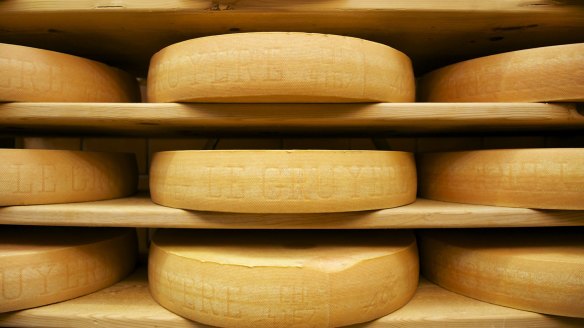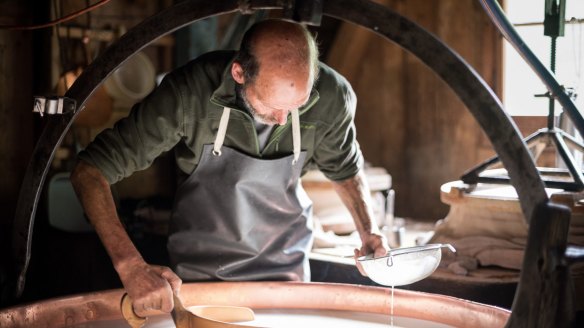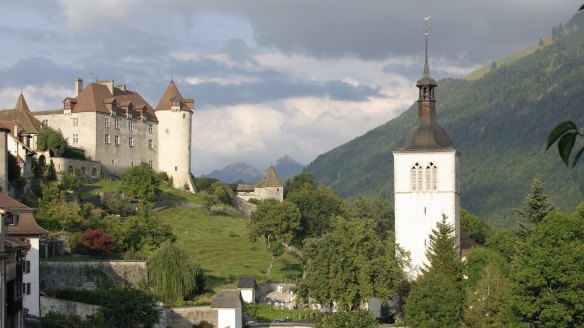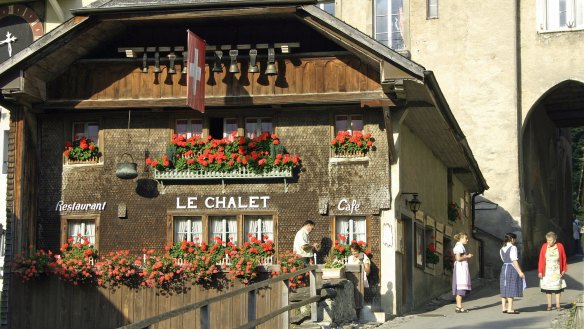The best reasons to visit Gruyeres, Switzerland (and they don't all involve cheese)

The countryside is vivid green and gently rolling, patchworked with fir woods and cherry orchards. Villages of red-roofed farmhouses hunker in soft valleys. The black-and-white cows that chew the lush meadows are a special breed that produces some of Switzerland's best-known cheeses: vacherin, emmental and gruyere.
The canton of Fribourg in western Switzerland is a plump, fertile region also known locally for its sausages, cured ham and lamb stewed with local grapes and accompanied by potatoes and caramelised pears. The regional dessert is a sweet paste made from chestnuts, served with crushed meringue and fresh whipped cream.
But it's Switzerland's most famous cheese that puts otherwise overlooked Fribourg on the map. Gruyere has probably been made in this quiet corner of French-speaking Switzerland since ancient times, although the name doesn't appear in writing until 1602.

AOP (origin-controlled) gruyere must be produced in Fribourg from the milk of cows that graze on alpine meadows between 800 and 1600 metres in altitude.
While the cheese is famous, not everyone realises that it's name comes from a small town of (almost) the same name, Gruyeres, only a half-hour drive north of Montreux on Lake Geneva.
Cheese aficionados have good reason to visit, but Gruyeres also happens to be one of Europe's best-preserved fortified medieval villages. It has a single main street but impressive encircling fortifications: a petite gem straight from the pages of the Brothers Grimm.

Fountains are draped in petunias, houses pastel-painted, oak doors cared with dwarves and animal heads. Wrought-iron signs dangle, depicting St George and a lizard-like dragon, or the crane (grue in French) that's the town emblem and depicted on its blue-and-white souvenir porcelain. In the village square and onetime marketplace, scoops hollowed out in stone blocks once provided standards for measuring out grain.
The village culminates in a small and somewhat gloomy castle, Chateau Gruyeres, built in the Italian style by the Count Louis II of Gruyeres in 1493. Pick your way through a collection of wooden chests, carved beds and battle loot, plus a rather peculiar mummified hand from Egypt. The drawing room has paintings by French painter Jean-Baptiste-Camille Corot. It's hardly a notable castle by European standards, but you can't beat the voluptuous green views from casement windows.
Below, the village is filled with cafes where waitresses in jolly skirts and white lace aprons dish up quiche and salads laden with gruyere, and slabs of plum tart accompanied by dense, delicious local cream. If you're after something more substantial, indulge in a fondue. The 1970s throwback is a still a staple in Switzerland, where it amounts to the national dish – though only consumed in winter.

Fondue is originally peasant fare that used up leftover cheese rinds. These days cheese is melted in a pot rubbed with garlic, with white wine and sometimes a dash of kirsch added. The blends and proportions of the cheese used (emmental, vacherin and sometimes appenzell) vary between regions and families, but gruyere is always the most important.
Dig into fondue at stone-flagged, flowerbox-draped Auberge de la Halle, whose terrace overlooks the village's cobbled main street. The fondue here is a traditional moitie-moitie (half-half) mix of gruyere and vacherin, but those looking for extra indulgence can add truffle or Chantilly cream. Another good option is Le Chalet de Gruyeres, where copper pots, cowbells and old farming implements hang from the rafters. They offer potatoes as well as the more usual bread cubes with their fondue. For something slightly lighter, the croute au fromage (which resembles cheese on toast) is nicely satisfying.
Gruyere is often used in baking because of its fine melting properties, making it the classic topping for a French onion soup crouton, filling for croque monsieur and ingredient for gratin. It excels as a table cheese, however. It's a hard, grainy but creamy cheese made from unpasteurised milk, quite salty from being cured in brine. The rind is slightly reddish and sticky and not an entirely pleasant smell. Gruyere becomes saltier and nuttier with age. The rare AOP cheese Gruyere Alpage is even more flavoursome.
Head into the meadows below the village walls to see how the cheese is made. La Maison de Gruyere has interactive displays and plate-glass windows through which you can watch gruyere being formed in huge yellow wheels. Narration through your headset comes from a cow called Cherry, and the piped sounds of clanking cowbells and gurgling streams accompany you into the exhibition space. Rather than yodelling grandfathers, white-aproned workers move between gleaming vats joined by steel pipes.
The process, though, is the same as it's always been. The milk is curdled, the whey separated from the heated cheese mass, and the cheese grains placed into moulds. The wheels are submerged in brine while the rind forms, then stored in humid cellars for several months. This factory produces 48 wheels of gruyere daily and has 7000 in storage.
Afterwards, head to Broc, a few minutes' drive away. The town is the headquarters of Switzerland's oldest chocolate company, Caillier, where you can tour the factory. Up above on a summer alp, Chez Boudji is a fabulous spot for rich cheese-laden food, with an interesting goat's cheese fondue for the brave. The old farmhouse sits in a gorgeous landscape of meadows and rocky peaks.
A little further along is the village of Cerniat, tucked into a fold of high valley amid meadows exploding with buttercups. Here the age-blackened, wonky-window chalet La Pinte des Mossettes provides a welcome change from the cholesterol-laden overdose. Its Michelin-starred chef, Romain Paillereau, produces elegant, unusual dishes such as pureed pike and herbs on brioche, or nettle-and-cumin waffles. Notably, there's an excellent gluten-free menu and many organic wines.
This region is on the edge of the Alps, so you won't get the expected Swiss scenery of snowy mountains but, instead buxom, rolling countryside rising towards rocky outcrops that hint of the Alps beyond. It's still magnificent, though. Don't miss the easy, five-kilometre Sentier des Fromageries (Path of the Cheese Dairies) that links Gruyeres and Moleson across flowery meadows and tinkling alpine streams.
Reward yourself at Fromagerie d'Alpage with a cheese-and-wine tasting on the terrace under jaunty, yellow parasols. The 1686 chalet is classified as a historic monument, and presents old-style cheese-making demonstrations in summer. Plump piebald cows clank their bells as you nibble, and all seems right with the world.
DETAILS
Auberge de la Halle, aubergehalle.ch
Le Chalet de Gruyeres, gruyereshotels.ch
La Maison de Gruyere, lamaisondugruyere.ch
Caillier, cailler.ch
Chez Boudji, boudji.ch
La Pinte des Mossettes, lapintedesmossettes.ch
Fromagerie d'Alpage, la-gruyere.ch/en/P4597/la-fromagerie-d-alpage
Brian Johnston travelled at his own expense.
